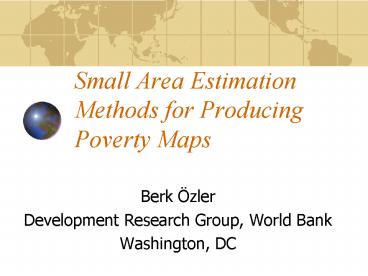Small Area Estimation Methods for Producing Poverty Maps - PowerPoint PPT Presentation
1 / 25
Title:
Small Area Estimation Methods for Producing Poverty Maps
Description:
Small Area Estimation Methods for Producing Poverty Maps. Berk zler ... Political economy of local decision-making. Within-country determinants of welfare outcomes. ... – PowerPoint PPT presentation
Number of Views:87
Avg rating:3.0/5.0
Title: Small Area Estimation Methods for Producing Poverty Maps
1
Small Area Estimation Methods for Producing
Poverty Maps
- Berk Özler
- Development Research Group, World Bank
- Washington, DC
2
Example Ecuador Poverty Map
- Provinces
Regions
Cantons
3
Example Eastern Cape Poverty Map
4
What are Poverty Maps?
- Not necessarily Maps rather,
- highly disaggregated databases of poverty and
inequality. - disaggregation need not be spatial
5
Why is there demand?
- Policy
- Geographic targeting of public policies
- Decentralization (fiscal, community
decision-making and implementation, etc.) - Research
- Political economy of local decision-making
- Within-country determinants of welfare outcomes.
- Impact maps
6
(No Transcript)
7
How to obtain a Poverty Map?
- Basic Problem
- Main source of information on distributional
outcomes - household surveys - permit only
limited disaggregation. - Very large data sources (e.g. census) typically
collect very limited information on welfare
outcomes.
8
How to obtain a Poverty Map?
- Options
- 1.Collect household data at highly disaggregated
levels - 2.Produce Basic Needs Index from census (and
other data sources) - 3.Apply small area estimation methods to combine
survey and census data.
9
Collecting Disaggregated Data
- Costly
- Time-consuming
- Quantity-Quality tradeoff
- Difficult to maintain comparability
10
Producing a Basic Needs Index
- Ad-hoc
- Often disputed (multiple maps)
- Interpretation? (povertylow income?)
11
Small Area Estimation Methods
- Combine Census and Survey Data
- Impute a measure of welfare from household survey
into census, using statistical prediction
methods. - Produces readily interpretable estimates
- Statistical precision can be gauged
- Encouraging results to date
- But, non-negligible data requirements
12
Methodology
- Detailed description in Elbers et al. (2003),
Econometrica. - Data pre-requisites
- high quality household sample survey and census
data are available for the same time period. Need
good measure of welfare (e.g. real per capita
consumption) - Census and household survey have a number of
variables in common (household demographics,
education levels, etc.)
13
Methodology
- Three Stages
- zero stage establish comparability of data
sources identify common variables understand
sampling strategy. - First stage estimate model of consumption in
the household survey based on common variables. - second stage take parameter estimates to census,
predict consumption, and estimate poverty and
inequality.
14
Methodology
- Zero Stage
- make or break can the exercise proceed?
- painstaking and very time consuming.
- not conceptually difficult.
- this cannot be done carefully enough-- you will
keep coming back to this stage.
15
Methodology
- First Stage
- We estimate
- ln yh xhß uh
- Where necessary we use cluster weights.
- Estimate separate regressions per stratum.
- For the disturbances, uh , we allow
- intra-cluster correlation (location effects)
- heteroskedasticity (household component of the
error) - non-normality
- (i.e. challenge uh ? (0, ?2), i.i.d.)
16
Methodology
- Second Stage
- Now, using census data, calculate...
- Xhß (draw ß from the VarCov (ß) )
- Add error components for the cluster and the
household (by drawing both errors from the
appropriate distribution) to calculate... - Xhß ?c eh
- Using the above, calculate desired welfare
measures
17
Methodology
- Second Stage
- Repeat this N (e.g. N 100) times.
- The mean over N simulations gives the point
estimate for the desired welfare measure, while
the standard deviation is the standard error of
that point estimate.
18
Methodology
- Standard Errors
- Difference between u, our estimator of the
expected value of W for the village, and the
actual level of welfare for the village may be
written as - W u (W-u) (u-û) (û- u)
- first component is idiosyncratic error.
- second component is model error.
- third component is computation error.
19
Methodology
- Second Stage
- 2 principal sources of error in the welfare
measure estimates produced by this method - model error is due to the fact that the
parameters from the first-stage equation are
estimated. - idiosyncratic error, is associated with the
disturbance term in the same model, which implies
that households actual expenditures deviate from
their expected values.
20
Methodology
- Second Stage
- While population size in a location does not
affect the model error, the idiosyncratic error
increases as the number of households in a target
population decreases. - A third potential source of error is associated
with computation methods. Elbers et al. found
this component to be negligible.
21
Experience
- Growing experience with method in IFPRI, WFP,
academia, The World Bank - Completed Maps
- Ecuador (2), Panama, Nicaragua, Guatemala,
Kenya, South Africa, Madagascar, Mozambique,
Malawi, Uganda, Cambodia, Vietnam. - Maps Underway
- Bolivia, Mexico, Zambia, Bulgaria, Albania,
Thailand, Indonesia, Papua New Guinea, Laos,
China.
22
How Low Can We Go?
23
(No Transcript)
24
Applications
- Targeting localities
- Overlay poverty distributions against other
indicators (deforestation, crime, cholera) - Survey to survey imputations
- Nutritional mapping (Cambodia)
- Within-country growth regressions (Kuznets type
analysis) using Panel poverty maps - Impact mapping
25
Cross Cutting Issues
- Emphasis on Process
- in-country work
- transfer of technique
- offers an entry-point for information based
policy making (e.g. Panama, Guatemala, South
Africa). - Squeezing more out of existing data
- Snap-shot dynamics pose additional challenges.
- Validation is needed

